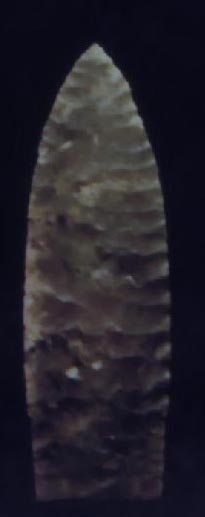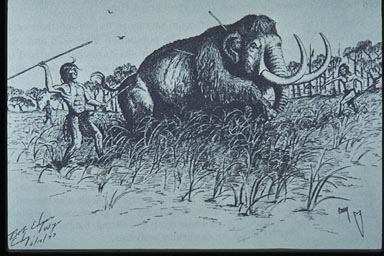THE KIDS PAGES
Home Page
Did You Know....
People first arrived in the Americas about 25,000 years ago. The first groups traveled into what is now Alaska from the region currently known as Siberia. These people hunted animals inhabiting grassland habitats in areas that are now under the Bering Sea. At that time (about 20,000-25,000 years ago), however, the land between Alaska and Siberia was exposed because ocean water was locked into very large glaciers that were created during the last ice-age. About 20,000 years ago, the glaciers began to melt and the ocean waters rose, flooding the bridge from Siberia to Alaska. Therefore, people could no longer move back and forth. Some groups remained in Alaska, or moved down the western coast of North America, and they became the ancestors of the Indian cultures that followed. They are not the direct ancestors of the Eskimos, however, as Eskimos are related to ocean-going cultures that arrived in the arctic a great deal later (about 3,000-4,000 years ago). The Indian's ancestors are called Paleoindians by archaeologists, which literally means "Old Indians."

Although most archaeologists believe that Paleoindians were living throughout the Americas (also called the "New World") by at least 15,000 years ago, the earliest indisputable, scientifically documented human occupation in the New World occurred about 13,800 years ago in the South American country of Chile. Since this is so far south of Alaska, it is assumed that people were also living elsewhere in the Americas by that time. We know for sure that Paleoindians were living in all parts of the New World from Canada to the southern tip of South America by 11,500 years ago (9,500 B.C.). They are recognized by a special type of large spear point (like the one to the right) that they made to hunt the very large animals that were used for food, clothing, shelter, and tools.
Paleoindians lived in a much different environment because it was the end of the ice age. Many of the animals they persued were very large, and are called "mega-fauna," which literally means very big animals. There were two species of elephants that Paleoindians hunted. One type, the mammoth, lived in colder parkland and tundra environments. The other was the mastodont, which lived in the forests of warmer areas. Mastodonts lived and were hunted in Georgia. Other types of mega-fauna hunted by Paleoindians in Georgia and elsewhere include giant bison, giant groundsloth, and giant (get the picture!!!) armadillos. These animals were truly giant. The bison were almost 7 ft high at the shoulders, and giant groundsloths were up to 12 ft high when they stood on their hind legs! Some giant armadillos weighed more than a ton! No wonder the Paleoindians needed large spear points!! They also had to be very brave and cunning to succesfully hunt these animals. It is important to remember, however, that these early people also hunted animals that still exist today, especially the white-tailed deer. They also fished and collected a wide variety of nuts, seeds, fruits, and grasses. By about 10,000 years ago, almost all of the mega-fauna had become extinct because of a changing environment; human hunting practices also played a role in the extinction process . The climate was becoming more like modern times. Plants and animals established new ecological communities as conditions stabilized, and people adpated to these new conditions by creating different types of tools and organizing their groups in different ways. Archaeologists call this next era the "Archaic Period."

Continue Kids Page